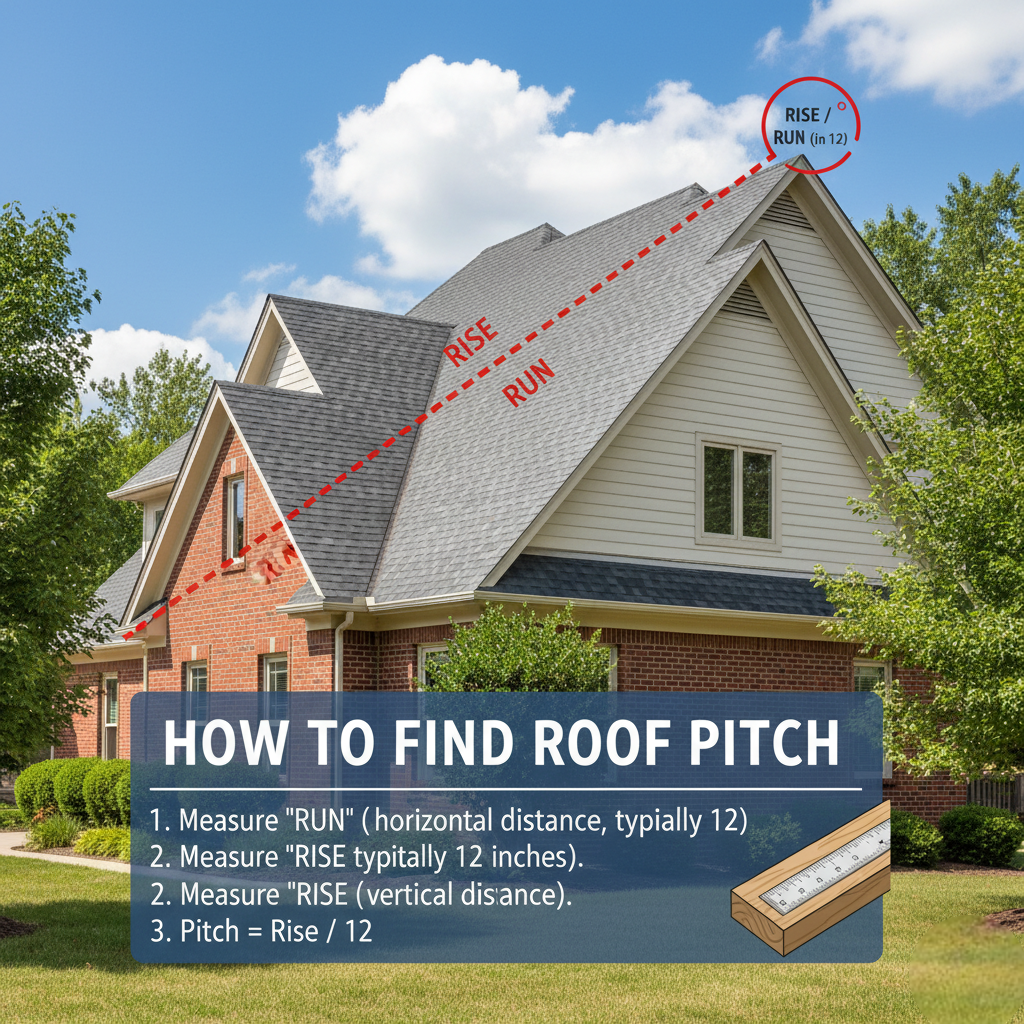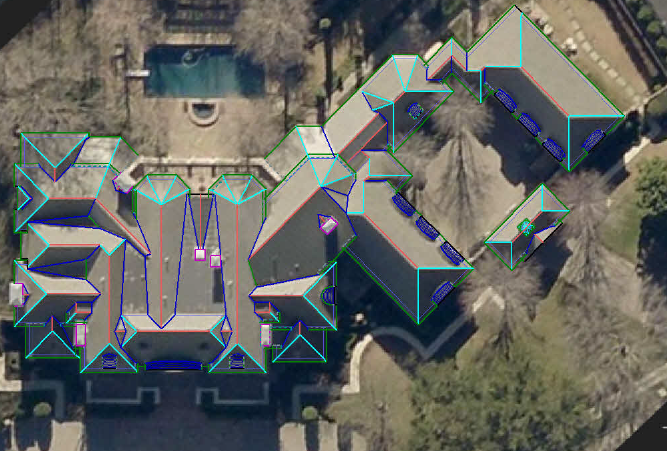It is important for roofers, contractors, and homeowners those want to re-roof or install to know how to find pitch of roof. The pitch of a roof determines not only the look of the structure, but also its drainage, overall materials, and safety in putting it up. In this simple, easy to follow, comprehensive guide, we will guide you through three simple, powerful steps to find your roof pitch — either on-site or remotely using technology.
Table of Contents
What Is Roof Pitch and Why It Matters
Roof pitch (or roof slope) is the angle or steepness of your roof. Usually a ratio of rise to run, a roof with a pitch of 6/12 means that for every 12 inches of horizontal distance it rises 6 inches vertically.
Knowing your roof’s pitch will help indicate:
- What type of materials can be used – Steeper roofs typically use shingles or tiles; flatter roofs may need membranes.
- The water run-off rate – how to find pitch of roof determines how efficiently the rainwater will shed from the roof and if it will leak.
- The amount of load the roof can hold – Engineers use pitch to determine load capacity.
- The look of the home – Pitch is part of your home’s architectural style.
Tools You Need How to Find Pitch of Roof
- Tape measure – For accurately measuring both the rise and the run.
- Level (minimum of 12 inches) – For accurately measuring level.
- Speed square or a digital angle finder – Useful for measuring slope angle.
- Calculator – For determining ratios or to convert degrees to pitch, if needed.
- Optional: Roof pitch app or online calculator – For measuring remotely with aerial imagery, either satellite imagery.

Step 1: Measure the Run (Horizontal Distance)
- If the roof surface can accommodate a level laid flat, lay your level horizontally on the roof surface.
- Mark a 12-inch run from one end of the level (or use the full length of your level if it’s exactly 12 inches).
- Again, confirm this is perfectly horizontal by using a bubble indicator.
The distance (12 inches) that you just measured represents the standard “run” to use when you are calculating pitch.
Step 2: Measure the Rise (Vertical Distance)
- From the twelve inch mark measure vertically from the surface of the roof to the level using the tape measure.
- The amount you get in inches is your rise.
For example, if the vertical measurement from the surface of the roof to the level is six inches, your roof will have a 6/12 pitch.
Step 3: Calculate and Record Your Roof Pitch
Once you have both rise and run, express the pitch as a ratio:
(Roof Pitch = Rise / Run) So if your rise is 6 and your run is 12, your pitch is 6/12.
Convert Roof Pitch to Degrees
If you prefer angle format, use this formula:
Angle = arctan ( Rise / Run )
Using a calculator or roof pitch chart, a 6/12 pitch equals 26.57° approximately.
Different Methods for Measuring Roof Pitch
You do not always have to climb up on the roof if not necessary. There are alternative ways, utilizing safe, more modern methods:
1. Roof pitch app/online calculator
Upload a large satellite image or enter the rise and run. Utilize websites like Aerial Estimation or a roof pitch app to provide you with accurate how to find pitch of roof data remotely.
2. From the ground with a phone
More and more mobile apps are available, utilizing your phone’s camera and/or gyro, to get slope angles from the ground, for safety and convenience.
3. Attic measurements
In the attic, using a rafter, measure the rise over a 12” horizontal run. It will provide the same pitch result without going to the roof.
Common Roof Pitch Ratios and Their Meanings
| Roof Pitch | Degrees (Approx.) | Roof Type | Typical Materials |
|---|---|---|---|
| 1/12 to 3/12 | 4.76°–14° | Low-slope | Membranes, EPDM, TPO |
| 4/12 to 6/12 | 18°–27° | Medium slope | Asphalt shingles |
| 7/12 to 9/12 | 30°–37° | Steep slope | Wood, metal shingles |
| 10/12 to 12/12 | 40°–45° | Very steep | Slate, tile |
Why Accurate Roof Pitch Measurement Matters
Choosing the right materials: Flat-roofing materials used on sloped roofs will leak.
- Accurate costing: Roofer will bid labor and materials on pitches.
- Safety and code compliance: Building codes of most municipalities will specify the minimum slope for nature to do its job.
- Perfectly aligned with design: An architect will use pitch as a design element to maintain symmetry throughout the design and in the building.
For example, even a 1/2 inch error to the rise could be costly in material and time either in the roofing or in the re-roofing process.
Pro Tips for How to Find Pitch of Roof Safely
- Do not take measurements while it is raining or windy.
- If you are getting on the roof, make sure you use high-quality ladders and wear proper safety gear.
- You may want to take measurements from different points of the roof just to be certain.
- Alternatively, with smarter tools available such as AerialEstimation.com, which has a satellite-derived pitch report that is quick without having to go on the roof.
Roof Pitch Conversion Chart (Rise per 12” Run)
| Pitch | Degrees | Pitch | Degrees |
|---|---|---|---|
| 2/12 | 9.46° | 8/12 | 33.69° |
| 3/12 | 14.04° | 9/12 | 36.87° |
| 4/12 | 18.43° | 10/12 | 39.81° |
| 5/12 | 22.62° | 11/12 | 42.51° |
| 6/12 | 26.57° | 12/12 | 45° |
| 7/12 | 30.26° | 14/12 | 49.40° |
Frequently Asked Questions (FAQ)
1. What is the most common roof pitch?
The most common range how to find pitch of roof in North America is 4/12 to 6/12, which is a middle-range pitch which gives you a relatively good style with easy maintenance.
2. Can you measure roof pitch without climbing?
Absolutely. There are numerous tools available (roof pitch calculator, or Services like satellite measurement) that allow you to find the roof pitch via a photo of the roof or the property blueprints.
3. how to find pitch of roof using Google Earth?
A way to find roof pitch is by using the measure tool in Google Earth Pro, then finding the horizontal and vertical distances, and finally putting this into the rise/run formula.
4. Are roof pitch and cost related?
Absolutely now the steeper a roof the more safety gear needed, or the more labour to put it on safely, and more that’s needed for materials, it is obviously going to increase cost.
Conclusion: How to Find Pitch of Roof to the Smart Way
Determining a roof’s pitch doesn’t have to be complex. Using a 3-step process — measure, calculate, and check you will get accurate measurements in a matter of minutes. Accurate pitch measurements are essential whether you are starting a roofing project or simply determining the specifications for your home. If you work with durable, beautiful, and cost-effective structures, you need accurate pitch measurements.
For hassle-free accuracy, consider using professional roof measurement services such as AerialEstimation.com. They provide immediate pitch/area/slope reports using satellite imagery – no ladder required!


